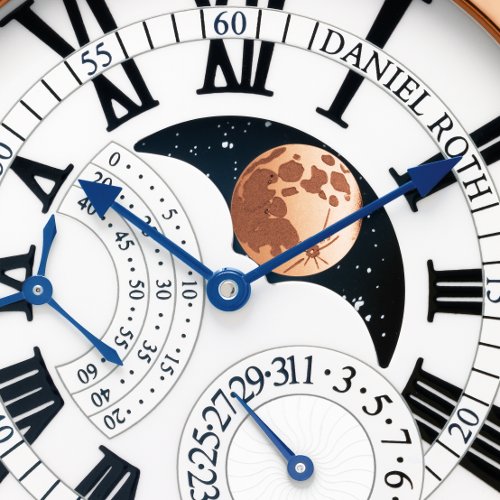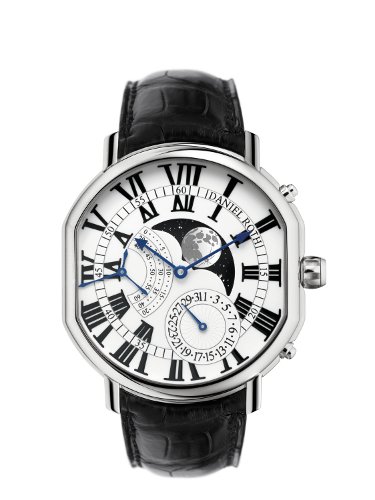 A quoi sert de contempler la lune sur sa montre si le mécanisme censé reproduire ses cycles n’est pas précis? A cette question, les maîtres horlogers Daniel Roth répondent, à l’issue de deux ans de développement, par un nouveau garde-temps qui vient enrichir la famille Athys et qui nécessitera un ajustement dans… 125 ans! D’où son nom: l’Athys Moon 2134. On ne pouvait rêver plus belle prouesse pour 2009, Année Internationale de l’Astronomie.
A quoi sert de contempler la lune sur sa montre si le mécanisme censé reproduire ses cycles n’est pas précis? A cette question, les maîtres horlogers Daniel Roth répondent, à l’issue de deux ans de développement, par un nouveau garde-temps qui vient enrichir la famille Athys et qui nécessitera un ajustement dans… 125 ans! D’où son nom: l’Athys Moon 2134. On ne pouvait rêver plus belle prouesse pour 2009, Année Internationale de l’Astronomie.
2009, année particulière pour Daniel Roth.
Cette année marque en effet le vingtième anniversaire de la marque et le quatre centième de la découverte de la lunette télescopique par un certain Galilée. En mai 1609, le physicien et astronome italien mettait au point le système optique qui lui permettrait, au bout de quelques mois et de nombreux essais, de découvrir la Lune, ses reliefs et ses imperfections, mais également le ciel et ses planètes. Pour célébrer cet événement qui a bouleversé l’histoire de l’humanité et ses connaissances de l’univers, l’Organisation des Nations Unies a décrété 2009 Année Internationale de l’Astronomie, désigné l’UNESCO comme agence pilote et chargé l’Union Astronomique Internationale de la mise en œuvre.

Une Grande Lune astronomique
Les maîtres horlogers Daniel Roth souhaitaient remédier aux dispositifs souvent imprécis des phases de lune. Dans les mécanismes standard, le disque affichant deux lunes comprend 59 dents. Entraîné par rotation d’un cran toutes les 24 heures, il effectue un demi-tour en 29 jours et 12 heures. Par rapport au véritable cycle lunaire (29 jours, 12 heures, 44 minutes et 2,8 secondes), l’affichage se trouve décalé de +44 minutes par lunaison, soit de +8,81 heures par an.
Beaucoup plus complexe et précis, le mécanisme de la lune astronomique de l’Athys Moon 2134 comprend trois mobiles. Le premier effectue une rotation complète en 24 heures, entraînant le second en 7 jours qui, à son tour, entraîne le disque de lune comportant 135 dents. Ce dernier fait un demi-tour en 29 jours, 12 heures et 45 minutes. L’erreur relative n’est donc plus que de -0,02 heure, soit 12 minutes, par an. La précision s’en trouvant considérablement augmentée, l’ajustement ne devient nécessaire que tous les… 125 ans!
 Le mouvement
Le mouvement
Première pour Daniel Roth, l’Athys Moon 2134 abrite un très beau calibre mécanique à remontage manuel (DR2300) sur base Frédéric Piguet 151, fabriqué dans la grande tradition horlogère, c’est‑à‑dire bénéficiant de décorations Haute Horlogerie, et conçu à l’origine pour des montres de gousset. Ce mouvement 16 lignes modifié (type Lépine) affiche l’emblématique aiguille des secondes à trois bras, alignée sur la couronne et faisant partie du train d’engrenage principal. Plus grand que ceux façonnés généralement par la Manufacture, il a nécessité la création d’une boîte adaptée à ses dimensions.
La famille Athys s’agrandit
Sobre et intemporelle, l’Athys Moon 2134 s’intègre naturellement à la désormais classique ligne du même nom dont elle perpétue les codes: grands chiffres romains, aiguilles en acier bleui, minuterie “chemin de fer” avec chiffres arabes et aiguille de la petite seconde à trois bras à 9h. A cela s’ajoute l’indication de la date à 5h et, entre 12h et 4h, le guichet de la lune en relief et de la même couleur d’or que la boîte. Les correcteurs prennent ici la forme de poussoirs afin de faciliter les opérations d’ajustement et d’éviter tout risque de rayure.
L’Athys Moon 2134 en bref
Exclusivité Daniel Roth, ce nouveau garde-temps est équipé du Calibre mécanique à remontage manuel DR 2300 type Lépine (16 lignes avec petite seconde alignée sur la couronne). Lancé à l’occasion de l’année astronomique (2009), il dispose d’un mécanisme d’affichage d’une grande lune dit précis, avec correction manuelle tous les 125 ans, d’où son nom: l’Athys Moon 2134. Le cadran laqué blanc indique les heures, les minutes, la petite seconde au moyen de l’emblématique aiguille à trois bras, la date et la grande lune dans un guichet en relief. Merveille de complexité, invitation à une contemplation enflammant l’imaginaire, l’Athys Moon 2134 ravira les amoureux de belle horlogerie et séduira les astronomes amateurs.
 What’s the point of admiring the moon on your watch if the mechanism designed to reproduce its cycles is not accurate? After two years of development, the master-watchmakers at Daniel Roth are responding to this question with a new timepiece that is enriching the Athys line and will require no adjustment for the next 125 years: hence its name, Athys Moon 2134. One could hardly have hoped for a finer or more symbolic feat to mark the International Year of Astronomy.
What’s the point of admiring the moon on your watch if the mechanism designed to reproduce its cycles is not accurate? After two years of development, the master-watchmakers at Daniel Roth are responding to this question with a new timepiece that is enriching the Athys line and will require no adjustment for the next 125 years: hence its name, Athys Moon 2134. One could hardly have hoped for a finer or more symbolic feat to mark the International Year of Astronomy.
2009, a special year for Daniel Roth.
This year marks both the brand’s 20th birthday and the 400th anniversary of Galileo’s invention of the world’s first telescope. In May 1609, the Italian physicist and astronomer devised an optical system that would enable him, after several months and countless trials, to view the Moon with all its mountains and craters, as well as the sky and its many planets. To celebrate the event that dramatically changed the history of humankind and its knowledge of the universe, the United Nations Organisation has declared 2009 the International Year of Astronomy, appointed UNESCO as the lead agency and the International Astronomical Union as the implementing body.
An astronomical Large Moon
The Daniel Roth master-watchmakers wished to improve the often inaccurate existing moon-phase displays. In standard mechanisms, the disc showing two moons comprises 59 teeth. Driven by a one-notch rotation every 24 hours, it performs a half-turn in 28 days and 12 hours. Compared with the real lunar cycle (29 days, 12 hours, 44 minutes and 2.8 seconds), the display thus accumulates a discrepancy of +44 minutes per lunar cycle, meaning +8.81 hours per year.
The far more complex and accurate astronomical moon-phase mechanism of the Athys Moon 2134 comprises three wheel-and-pinion sets. The first performs a full rotation in 24 hours, driving the second in 7 days, which in turn drives the 135-tooth moon disc. The latter completes a half-turn in 29 days, 12 hours and 45 minutes, which means the relative error amounts to just -0.02 hours or 12 minutes per year. This greatly improved accuracy means adjustment is required just once every 125 years!
The movement
Representing a first for Daniel Roth, the Athys Moon 2134 houses an extremely beautiful mechanical hand-wound calibre (DR2300) developed on a Frédéric Piguet 151 base movement. Crafted in harmony with the noblest watchmaking traditions including exquisite Haute Horlogerie finishing and originally designed for pocket-watches, this modified 16-lignes Lépine type movement powers the brand’s iconic three-arm seconds hand, aligned with the crown and constituting an integral part of the main gear train. Larger than the movements generally made by the Manufacture, it called for the creation of a case suited to its generous stature.
A worthy addition to the Athys family
The understated and timelessly elegant Athys Moon 2134 finds its natural place within the classic line of which it reflects the main signature characteristics: large Roman numerals, blued steel hands, a “railtrack” minute circle with Arabic numerals and a three-arm seconds hand at 9 o’clock. These distinctive features are complemented by a date display at 4 o’clock, a raised depiction of the moon between 12 and 4 o’clock in the same colour as the case. The correctors on this model are pushpieces designed to facilitate adjustment operations and avoid any risk of scratching.
The Athys Moon 2134 in a nutshell.
This exclusive new Daniel Roth timepiece is equipped with a Lépine type mechanical hand-wound DR Calibre 2300 (16 lignes and small seconds lined up with the crown). Launched on the occasion of the International Year of Astronomy (2009), it features an extremely accurate large moon-phase display requiring manual correction only once very 125 years – hence its name evoking the next scheduled adjustment: Athys Moon 2134. The white-lacquered dial carries hour and minute hands, the brand’s characteristic three-arm seconds hand, a date display and a raised large moon display appearing through a window. A spectacularly complex feat and an invitation to a form of contemplation that inevitably fires the imagination. The Athys Moon 2134 is destined to delight fine watchmaking enthusiasts as well as appealing to amateur astronomers.
